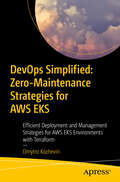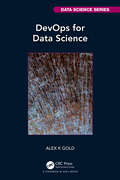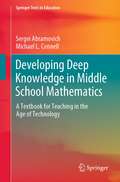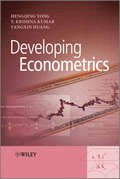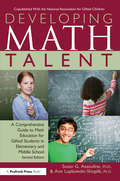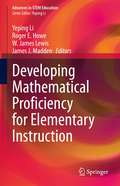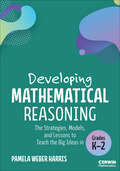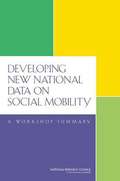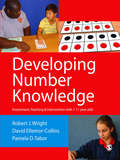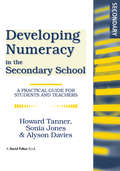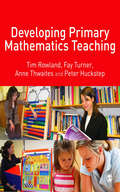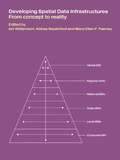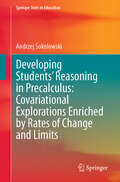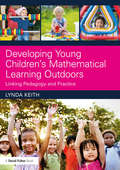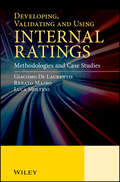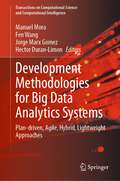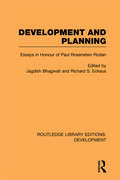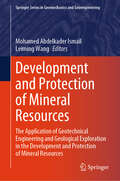- Table View
- List View
Deutungen und Anwendungen von Äquivalenzumformungen (Studien zur theoretischen und empirischen Forschung in der Mathematikdidaktik)
by Norbert NosterIm Zentrum der Arbeit steht der Begriff der Äquivalenzumformung, welcher zunächst im Rahmen des Lösens von Gleichungen und anschließend eigenständig diskutiert wird. Diese Diskussion wird um die Einbeziehung sprachwissenschaftlicher Ansätze erweitert, wodurch das Individuum durch Fragen nach der mentalen Repräsentation bzw. Deutung sowie der Anwendung von Äquivalenzumformung in unterschiedlichen Kontexten in den Vordergrund rückt. Zur Untersuchung der Fragen wurde ein Instrument entwickelt, das an einer Stichprobe von 271 Schülerinnen und Schüler (Realschule & Gymnasium) der Jahrgangsstufen neun und zehn eingesetzt wurde. Hierbei werden mittels qualitativer Inhaltsanalyse verschiedene Deutungen identifiziert, die auf unterschiedliche Umformungsregeln hinweisen und zum Teil mit Leistungsunterschieden einhergehen. Darüber hinaus wird gezeigt, dass sich Lösen, Normieren sowie Umstellen von Gleichungen als Anwendungen von Äquivalenzumformungen mittels konfirmatorischer Faktorenanalyse empirisch trennen lassen.
DevOps Simplified: Efficient Deployment and Management Strategies for AWS EKS Environments with Terraform
by Dmytro KozhevinGain the knowledge and practical skills needed to deploy a fully functional, secure, and scalable application in AWS EKS. This book is a hands-on guide designed to help you navigate and manage infrastructure in the AWS EKS environment. The book starts by reviewing the concept of DevOps flexibility, emphasizing adaptability to manage changes effectively. It covers foundational elements like IAM basics, user management, and the use of Terraform for infrastructure as code, highlighting the importance of version stability and unique CIDR blocks. Moving forward, you’ll explore Kubernetes, and its initial set-up steps, such as configuration management, access control, and storage. You’ll also see how to bridge Kubernetes with AWS resources, touching upon service accounts, identity federation, and policy assignment. In the final chapters, the book guides you through the complete setup of a fully working application using Terraform. The book culminates with a step-by-step walkthrough of deploying a complete application environment where you’ll generate and distribute access credentials, configure persistent storage, and manage RBAC for users, all using Terraform. Zero-Maintenance Strategies for AWS EKS will provide you with a solid foundation and a toolkit of proven strategies for managing cloud infrastructure. What You Will Learn Understand the concept of DevOps flexibility and its practical applications Acquire foundational knowledge in IAM basics and user management. Manage external access to your applications while consolidating load balancing through a single, entry point. Securely configure DNS and SSL, ensuring your application is both accessible and protected. Who This Book Is For DevOps professionals, IT managers, and software developers who are looking to adopt or improve their DevOps practices, and students and educators in IT-related fields.
DevOps for Data Science (Chapman & Hall/CRC Data Science Series)
by Alex GoldData Scientists are experts at analyzing, modelling and visualizing data but, at one point or another, have all encountered difficulties in collaborating with or delivering their work to the people and systems that matter. Born out of the agile software movement, DevOps is a set of practices, principles and tools that help software engineers reliably deploy work to production. This book takes the lessons of DevOps and aplies them to creating and delivering production-grade data science projects in Python and R.This book’s first section explores how to build data science projects that deploy to production with no frills or fuss. Its second section covers the rudiments of administering a server, including Linux, application, and network administration before concluding with a demystification of the concerns of enterprise IT/Administration in its final section, making it possible for data scientists to communicate and collaborate with their organization’s security, networking, and administration teams.Key Features:• Start-to-finish labs take readers through creating projects that meet DevOps best practices and creating a server-based environment to work on and deploy them.• Provides an appendix of cheatsheets so that readers will never be without the reference they need to remember a Git, Docker, or Command Line command.• Distills what a data scientist needs to know about Docker, APIs, CI/CD, Linux, DNS, SSL, HTTP, Auth, and more.• Written specifically to address the concern of a data scientist who wants to take their Python or R work to production.There are countless books on creating data science work that is correct. This book, on the otherhand, aims to go beyond this, targeted at data scientists who want their work to be than merely accurate and deliver work that matters.
Developing Deep Knowledge in Middle School Mathematics: A Textbook for Teaching in the Age of Technology (Springer Texts in Education)
by Sergei Abramovich Michael L. ConnellThis textbook is for prospective teachers of middle school mathematics. It reflects on the authors’ experience in offering various mathematics education courses to prospective teachers in the US and Canada. In particular, the content can support one or more of 24-semester-hour courses recommended by the Conference Board of the Mathematical Sciences (2012) for the mathematical preparation of middle school teachers. The textbook integrates grade-appropriate content on all major topics in the middle school mathematics curriculum with international recommendations for teaching the content, making it relevant for a global readership. The textbook emphasizes the inherent connections between mathematics and real life, since many mathematical concepts and procedures stem from common sense, something that schoolchildren intuitively possess. This focus on teaching formal mathematics with reference to real life and common sense is essential to its pedagogical approach. In addition, the textbook stresses the importance of being able to use technology as an exploratory tool, and being familiar with its strengths and weaknesses. In keeping with this emphasis on the use of technology, both physical (manipulatives) and digital (commonly available educational software), it also explores e.g. the use of computer graphing software for digital fabrication. In closing, the textbook addresses the issue of creativity as a crucial aspect of education in the digital age in general, and in mathematics education in particular.
Developing Econometrics
by Hengqing Tong T. Krishna Kumar Yangxin HuangStatistical Theories and Methods with Applications to Economics and Business highlights recent advances in statistical theory and methods that benefit econometric practice. It deals with exploratory data analysis, a prerequisite to statistical modelling and part of data mining. It provides recently developed computational tools useful for data mining, analysing the reasons to do data mining and the best techniques to use in a given situation.Provides a detailed description of computer algorithms.Provides recently developed computational tools useful for data miningHighlights recent advances in statistical theory and methods that benefit econometric practice.Features examples with real life data.Accompanying software featuring DASC (Data Analysis and Statistical Computing).Essential reading for practitioners in any area of econometrics; business analysts involved in economics and management; and Graduate students and researchers in economics and statistics.
Developing Fractions Knowledge (Math Recovery)
by Robert J Wright Anderson Norton Amy J HackenbergSupporting and understanding your students' fractional knowledge is crucial to their overall grasp of numbers and mathematics. By centralising around three key stages of development, this effective guide will help you to assess your students' understanding of fractions and modify your teaching accordingly. These key stages are identified as: · Stage 1a: Fair Sharing · Stage 1b: Part-Whole · Stage 2a: Disembedding and Iterating · Stage 2b: Measuring with Unit Fractions · Stage 2c: Reversing Fractions · Stage 3a: Fractions as Numbers · Stage 3b: Operating with Fractions As the newest addition to the bestselling Maths Recovery series, this book will be a useful guide for all primary classroom teachers and assistants, including experienced Mathematics Recovery instructors.
Developing Math Talent
by Ann Lupowski-Shoplik Susan G. AssoulineBuild student success in math with the only comprehensive guide for developing math talent among advanced learners. The authors, nationally recognized math education experts, offer a focused look at educating gifted and talented students for success in math. More than just a guidebook for educators, this book offers a comprehensive approach to mathematics education for gifted students of elementary or middle school age.
Developing Math Talent: A Comprehensive Guide to Math Education for Gifted Students in Elementary and Middle School
by Susan G. Assouline Ann Lupkowski-ShoplikBuild student success in math with the only comprehensive guide for developing math talent among advanced learners. The authors, nationally recognized math education experts, offer a focused look at educating gifted and talented students for success in math. More than just a guidebook for educators, this book offers a comprehensive approach to mathematics education for gifted students of elementary or middle school age.The authors provide concrete suggestions for identifying mathematically talented students, tools for instructional planning, and specific programming approaches. Developing Math Talent features topics such as strategies for identifying mathematically gifted learners, strategies for advocating for gifted children with math talent, how to design a systematic math education program for gifted students, specific curricula and materials that support success, and teaching strategies and approaches that encourage and challenge gifted learners.
Developing Mathematical Proficiency for Elementary Instruction (Advances in STEM Education)
by Yeping Li W. James Lewis James J. Madden Roger E. HoweThe need to improve the mathematical proficiency of elementary teachers is well recognized, and it has long been of interest to educators and researchers in the U.S. and many other countries. But the specific proficiencies that elementary teachers need and the process of developing and improving them remain only partially conceptualized and not well validated empirically. To improve this situation, national workshops were organized at Texas A&M University to generate focused discussions about this important topic, with participation of mathematicians, mathematics educators and teachers. Developing Mathematical Proficiency for Elementary Instruction is a collection of articles that grew out of those exciting cross-disciplinary exchanges. Developing Mathematical Proficiency for Elementary Instruction is organized to probe the specifics of mathematical proficiency that are important to elementary teachers during two separate but inter-connected professional stages: as pre-service teachers in a preparation program, and as in-service teachers teaching mathematics in elementary classrooms. From this rich and inspiring collection, readers may better understand, and possibly rethink, their own practices and research in empowering elementary teachers mathematically and pedagogically, as educators or researchers.
Developing Mathematical Reasoning: Avoiding the Trap of Algorithms (Corwin Mathematics Series)
by Pamela Weber HarrisMath is not rote-memorizable. Math is not random-guessable. Math is figure-out-able. Author Pam Harris argues that teaching real math—math that is free of distortions–will reach more students more effectively and result in deeper understanding and longer retention. This book is about teaching undistorted math using the kinds of mental reasoning that mathematicians do. Memorization tricks and algorithms meant to make math "easier" are full of traps that sacrifice long-term student growth for short-lived gains. Students and teachers alike have been led to believe that they’ve learned more and more math, but in reality their brains never get any stronger. Using these tricks may make facts easier to memorize in isolation, but that very disconnect distorts the reality of math. The mountain of trivia piles up until students hit a breaking point. Humanity′s most powerful system of understanding, organizing, and making an impact on the world becomes a soul-draining exercise in confusion, chaos, and lost opportunities. Developing Mathematical Reasoning: Avoiding the Trap of Algorithms emphasizes the importance of teaching students increasingly sophisticated mathematical reasoning and understanding underlying concepts rather than relying on a set rule for solving problems. This book illuminates a hierarchy of mathematical reasoning to help teachers guide students through various domains of math development, from basic counting and adding to more complex proportional and functional reasoning. Everyone is capable of understanding and doing real math. This book: Highlights the important mathematical relationships, strategies, and models for students to develop Offers personal stories, reflection sections, and extensive practical exercises for easy implementation Includes real math—a lot of it—to provide teachers with examples they can put to use in their classrooms immediately This book is a valuable resource for educators looking to reach more students by building a strong foundation of mathematical thinking in their students. By addressing common misconceptions about math and providing practical strategies for teaching real math, this book shows that everyone can use the mathematical relationships they already know to reason about new relationships. In other words, everyone can math.
Developing Mathematical Reasoning: Avoiding the Trap of Algorithms (Corwin Mathematics Series)
by Pamela Weber HarrisMath is not rote-memorizable. Math is not random-guessable. Math is figure-out-able. Author Pam Harris argues that teaching real math—math that is free of distortions–will reach more students more effectively and result in deeper understanding and longer retention. This book is about teaching undistorted math using the kinds of mental reasoning that mathematicians do. Memorization tricks and algorithms meant to make math "easier" are full of traps that sacrifice long-term student growth for short-lived gains. Students and teachers alike have been led to believe that they’ve learned more and more math, but in reality their brains never get any stronger. Using these tricks may make facts easier to memorize in isolation, but that very disconnect distorts the reality of math. The mountain of trivia piles up until students hit a breaking point. Humanity′s most powerful system of understanding, organizing, and making an impact on the world becomes a soul-draining exercise in confusion, chaos, and lost opportunities. Developing Mathematical Reasoning: Avoiding the Trap of Algorithms emphasizes the importance of teaching students increasingly sophisticated mathematical reasoning and understanding underlying concepts rather than relying on a set rule for solving problems. This book illuminates a hierarchy of mathematical reasoning to help teachers guide students through various domains of math development, from basic counting and adding to more complex proportional and functional reasoning. Everyone is capable of understanding and doing real math. This book: Highlights the important mathematical relationships, strategies, and models for students to develop Offers personal stories, reflection sections, and extensive practical exercises for easy implementation Includes real math—a lot of it—to provide teachers with examples they can put to use in their classrooms immediately This book is a valuable resource for educators looking to reach more students by building a strong foundation of mathematical thinking in their students. By addressing common misconceptions about math and providing practical strategies for teaching real math, this book shows that everyone can use the mathematical relationships they already know to reason about new relationships. In other words, everyone can math.
Developing Mathematical Reasoning: The Strategies, Models, and Lessons to Teach the Big Ideas in Grades K-2 (Corwin Mathematics Series)
by Pamela Weber HarrisMath is not rote-memorizable. Math is not random-guessable. Math is figure-out-able. Author Pam Harris argues that teaching real math—math that is free of distortions—will reach more students more effectively and result in deeper understanding and longer retention. This book is about teaching undistorted math using the kinds of mental reasoning that mathematicians do. Memorization tricks and algorithms meant to make math "easier" are full of traps that sacrifice long-term student growth for short-lived gains. Students and teachers alike have been led to believe that they’ve learned more and more math, but in reality their brains never get any stronger. Using these tricks may make facts easier to memorize in isolation, but that very disconnect distorts the reality of math. In her landmark book Developing Mathematical Reasoning: Avoiding the Trap of Algorithms, Pam emphasizes the importance of teaching students increasingly sophisticated mathematical reasoning and understanding underlying concepts rather than relying on a set rule for solving problems. Now, in this first companion volume, Developing Mathematical Reasoning: The Strategies, Models, and Lessons to Teach the Big Ideas in Grades K-2, she demonstrates how counting and additive strategies serve as the foundation for creating efficient, accurate, and flexible thinkers. Everyone is capable of understanding and doing real math. This book: Gives step-by-step guidance on how to teach the strategies, models, and big ideas that foster confidence and long-term success, preparing students for increasingly complex mathematical challenges Offers the "what to do" to teach counting, addition, and subtraction in ways that promote reasoning over rote memorization Provides practical tools such as problem strings, models, classroom routines, and discussion questions designed to implement reasoning-based practices Includes supporting resources for creating a classroom culture where students see math as figure-out-able and gain confidence as mathematical thinkers By addressing common misconceptions about math and providing practical strategies for teaching real math, this book shows that everyone can use the mathematical relationships they already know to reason about new relationships. In other words, everyone can math-even the very youngest students!
Developing Mathematical Reasoning: The Strategies, Models, and Lessons to Teach the Big Ideas in Grades K-2 (Corwin Mathematics Series)
by Pamela Weber HarrisMath is not rote-memorizable. Math is not random-guessable. Math is figure-out-able. Author Pam Harris argues that teaching real math—math that is free of distortions—will reach more students more effectively and result in deeper understanding and longer retention. This book is about teaching undistorted math using the kinds of mental reasoning that mathematicians do. Memorization tricks and algorithms meant to make math "easier" are full of traps that sacrifice long-term student growth for short-lived gains. Students and teachers alike have been led to believe that they’ve learned more and more math, but in reality their brains never get any stronger. Using these tricks may make facts easier to memorize in isolation, but that very disconnect distorts the reality of math. In her landmark book Developing Mathematical Reasoning: Avoiding the Trap of Algorithms, Pam emphasizes the importance of teaching students increasingly sophisticated mathematical reasoning and understanding underlying concepts rather than relying on a set rule for solving problems. Now, in this first companion volume, Developing Mathematical Reasoning: The Strategies, Models, and Lessons to Teach the Big Ideas in Grades K-2, she demonstrates how counting and additive strategies serve as the foundation for creating efficient, accurate, and flexible thinkers. Everyone is capable of understanding and doing real math. This book: Gives step-by-step guidance on how to teach the strategies, models, and big ideas that foster confidence and long-term success, preparing students for increasingly complex mathematical challenges Offers the "what to do" to teach counting, addition, and subtraction in ways that promote reasoning over rote memorization Provides practical tools such as problem strings, models, classroom routines, and discussion questions designed to implement reasoning-based practices Includes supporting resources for creating a classroom culture where students see math as figure-out-able and gain confidence as mathematical thinkers By addressing common misconceptions about math and providing practical strategies for teaching real math, this book shows that everyone can use the mathematical relationships they already know to reason about new relationships. In other words, everyone can math-even the very youngest students!
Developing New National Data on Social Mobility: A Workshop Summary
by Amy Smith"Developing New National Data on Social Mobility" summarizes a workshop convened in June 2013 to consider options for a design for a new national survey on social mobility. The workshop was sponsored by the National Science Foundation and convened by the Committee on Population and the Committee on National Statistics Division of Behavioral and Social Sciences and Education of the National Research Council. Scientific experts from a variety of social and behavioral disciplines met to plan a new national survey on social mobility that will provide the first definitive evidence on recent and long-term trends in social mobility, with the objectives of coming to an understanding of the substantial advances in the methods and statistics for modeling mobility, in survey methodology and population-based survey experiments, in opportunities to merge administrative and survey data, and in the techniques of measuring race, class, education, and income. The workshop also focused on documenting the state of understanding of the mechanisms through which inequality is generated in the past four decades. In the absence of a survey designed and dedicated to the collection of information to assess the status of social mobility, a wide variety of data sources designed for other purposes have been pressed into service in order to illuminate the state of social mobility and its trends. "Developing New National Data on Social Mobility" discusses the key decision points associated with launching a new national level survey of social mobility. This report considers various aspects of a major new national survey, including identifying relevant new theoretical perspectives and technical issues that have implications for modeling, measurement, and data collection.
Developing Number Knowledge: Assessment,Teaching and Intervention with 7-11 year olds (Math Recovery)
by Robert J Wright Pamela D Tabor David Ellemor-CollinsFollowing the great success of the earlier books, this fourth book in the Mathematics Recovery series equips teachers with detailed pedagogical knowledge and resources for teaching number to 7 to 11-year olds. Drawing on extensive programs of research, curriculum development, and teacher development, the book offers a coherent, up-to-date approach emphasising computational fluency and the progressive development of students′ mathematical sophistication. The book is organized in key domains of number instruction, including structuring numbers 1 to 20, knowledge of number words and numerals, conceptual place value, mental computation, written computation methods, fractions, and early algebraic reasoning. Features include: fine-grained progressions of instruction within each domain; detailed descriptions of students′ strategies and difficulties; assessment tasks with notes on students′ responses; classroom-ready instructional activities; This book is designed for classroom and intervention teachers, special education teachers and classroom assistants. The book is an invaluable resource for mathematics advisors and coaches, learning support staff, numeracy consultants, curriculum developers, teacher educators and researchers.
Developing Numeracy in the Secondary School: A Practical Guide for Students and Teachers
by Howard Tanner Sonia Jones Alyson DaviesAs the National Numeracy Strategy (NNS) extends into secondary schools this book for trainee and practicing mathematics teachers provides practical guidance on developing effective strategies for the teaching of numeracy at KS3 and 4 based on the DfEE requirements. The teaching and learning approaches suggested in the NNS are analyzed and explained using case-study examples from secondary schools. Many of these ideas were developed by teacher inquiry groups in the Raising Standards in Numeracy project. The book includes examples of pupils' work; lesson plans and pupil activities; ideas for using ICT to enhance mathematics; teacher guidance on both teaching and assessment; and ideas for developing numeracy across the curriculum. This book offers an introduction to the subject of numeracy accompanied by lesson ideas and practical guidance. It will prove a valuable resource for all trainee and new mathematics teachers.
Developing Primary Mathematics Teaching: Reflecting on Practice with the Knowledge Quartet
by Fay Turner Tim Rowland E Anne Thwaites Peter HuckstepHow can KS1/2 teachers improve their mathematics teaching? This book helps readers to become better, more confident teachers of mathematics by enabling them to focus critically on what they know and what they do in the classroom. Building on their close observation of primary mathematics classrooms, the authors provide those starting out in the teaching profession with a four-stage framework which acts as a tool of support for developing their teaching: - making sense of foundation knowledge - focusing on what teachers know about mathematics - transforming knowledge - representing mathematics to learners through examples, analogies, illustrations and demonstrations - connection - helping learners to make sense of mathematics through understanding how ideas and concepts are linked to each other - contingency - what to do when the unexpected happens Each chapter includes practical activities, lesson descriptions and extracts of classroom transcripts to help teachers reflect on effective practice.
Developing Spatial Data Infrastructures: From Concept to Reality
by Ian Williamson Abbas Rajabifard Mary-Ellen F.FeeneyExpert perspectives on SDI theory and practiceThe spatial data infrastructure (SDI) concept continues to evolve and become an increasingly important element of the infrastructure that supports economic development, environmental management, and social stability. Because of its dynamic and complex nature, however, it remains a fuzzy concept
Developing Students’ Reasoning in Precalculus: Covariational Explorations Enriched by Rates of Change and Limits (Springer Texts in Education)
by Andrzej SokolowskiThis book aims to develop high school and undergraduate students’ covariational reasoning and algebraic skills to succeed in calculus and STEM subjects. The book reflects on contemporary research in math education where students explore algebraic tools and reason mathematically to construct new knowledge. The volume is made up of six chapters covering polynomial, rational, and transcendental functions. An early introduction of limits to support the analyses of linear functions progresses to other book chapters ensuring consistency, parallelism, and a scaffold knowledge delivery. A gradual introduction to function rates of change along with function monotonicity and concavity intertwines with modeling techniques that merge students’ mathematical reasoning with scientific contexts. A forthcoming online component of the book consists of ready-to-download exploratory modeling activities and worksheets that further solidify students’ fluency in understanding how to apply abstract math concepts to gain a deeper understanding of natural and social sciences.
Developing Young Children’s Mathematical Learning Outdoors: Linking Pedagogy and Practice
by Lynda KeithDeveloping Young Children’s Mathematical Learning Outdoors provides detailed guidance and practical advice on planning mathematical experiences for young children outdoors. By examining the key features of a mathematically rich outdoor environment, it illustrates how this can motivate children in leading their own learning and mathematical thinking.Drawing upon the author’s wealth of experience, the book provides support for students and early years' practitioners in developing a deeper understanding of how to plan quality experiences, which combine pedagogy with effective practice. Covering all aspects of mathematics, it identifies meaningful contexts and shows how adults can use open-ended questions and prompts to promote children’s mathematical play outside.With rich case studies and reflective questions included throughout, as well as suggestions for useful resources to put the ideas in the book into practice, it is essential reading for all those that want to develop curious and creative mathematical thinkers in the early years.
Developing a 21st Century Global Library for Mathematics Research
by Committee on Planning a Global Library of the Mathematical SciencesLike most areas of scholarship, mathematics is a cumulative discipline: new research is reliant on well-organized and well-curated literature. Because of the precise definitions and structures within mathematics, today's information technologies and machine learning tools provide an opportunity to further organize and enhance discoverability of the mathematics literature in new ways, with the potential to significantly facilitate mathematics research and learning. Opportunities exist to enhance discoverability directly via new technologies and also by using technology to capture important interactions between mathematicians and the literature for later sharing and reuse. "Developing a 21st Century Global Library for Mathematics Research" discusses how information about what the mathematical literature contains can be formalized and made easier to express, encode, and explore. Many of the tools necessary to make this information system a reality will require much more than indexing and will instead depend on community input paired with machine learning, where mathematicians' expertise can fill the gaps of automatization. This report proposes the establishment of an organization; the development of a set of platforms, tools, and services; the deployment of an ongoing applied research program to complement the development work; and the mobilization and coordination of the mathematical community to take the first steps toward these capabilities. The report recommends building on the extensive work done by many dedicated individuals under the rubric of the World Digital Mathematical Library, as well as many other community initiatives. "Developing a 21st Century Global Library for Mathematics" envisions a combination of machine learning methods and community-based editorial effort that makes a significantly greater portion of the information and knowledge in the global mathematical corpus available to researchers as linked open data through a central organizational entity-referred to in the report as the Digital Mathematics Library. This report describes how such a library might operate - discussing development and research needs, role in facilitating discover and interaction, and establishing partnerships with publishers.
Developing, Validating and Using Internal Ratings
by Giacomo De Laurentis Renato Maino Luca MolteniThis book provides a thorough analysis of internal rating systems. Two case studies are devoted to building and validating statistical-based models for borrowers' ratings, using SPSS-PASW and SAS statistical packages. Mainstream approaches to building and validating models for assigning counterpart ratings to small and medium enterprises are discussed, together with their implications on lending strategy.Key Features:* Presents an accessible framework for bank managers, students and quantitative analysts, combining strategic issues, management needs, regulatory requirements and statistical bases.* Discusses available methodologies to build, validate and use internal rate models.* Demonstrates how to use statistical packages for building statistical-based credit rating systems.* Evaluates sources of model risks and strategic risks when using statistical-based rating systems in lending.This book will prove to be of great value to bank managers, credit and loan officers, quantitative analysts and advanced students on credit risk management courses.
Development Methodologies for Big Data Analytics Systems: Plan-driven, Agile, Hybrid, Lightweight Approaches (Transactions on Computational Science and Computational Intelligence)
by Manuel Mora Jorge Marx Gomez Fen Wang Hector Duran-LimonThis book presents research in big data analytics (BDA) for business of all sizes. The authors analyze problems presented in the application of BDA in some businesses through the study of development methodologies based on the three approaches – 1) plan-driven, 2) agile and 3) hybrid lightweight. The authors first describe BDA systems and how they emerged with the convergence of Statistics, Computer Science, and Business Intelligent Analytics with the practical aim to provide concepts, models, methods and tools required for exploiting the wide variety, volume, and velocity of available business internal and external data - i.e. Big Data – and provide decision-making value to decision-makers. The book presents high-quality conceptual and empirical research-oriented chapters on plan-driven, agile, and hybrid lightweight development methodologies and relevant supporting topics for BDA systems suitable to be used for large-, medium-, and small-sized business organizations.
Development and Planning: Essays in Honour of Paul Rosenstein-Rodan (Routledge Library Editions: Development)
by Paul Rosenstein RodanFirst published in 1972, this is a book of essays offered in honour of Paul Rosenstein-Rodan, the distinguished economist whose career started in mid-1920s Vienna and subsequently spanned Europe, Britain, the USA and many of the less developed countries of the world.The book includes reviews of past developments, chapters on development trade and value theory, an assessment of contemporary emerging economic patterns, development and trade policy, and investment policy. Further essays cover the intellectual history of development economics, general aspects of growth and economic policy in underdeveloped countries and the problems of income distribution and sectoral and regional development.
Development and Protection of Mineral Resources: The Application of Geotechnical Engineering and Geological Exploration in the Development and Protection of Mineral Resources (Springer Series in Geomechanics and Geoengineering)
by Mohamed Abdelkader Ismail Leiming WangThis book comprises papers that showcase recent advancements and applications of innovative technologies in mining, offering theoretical insights and practical references for industry professionals. The 8th International Conference on Mineral Resources, Geotechnology and Geological Exploration (MRGGE 2024) was successfully held on June 14-16, 2024, in Shijiazhuang, China. This conference aims to address the dual challenge of providing essential mineral resources while ensuring environmental protection and sustainability in the mining industry. The proceedings encompass a wide range of topics, including ecological restoration of mines, geotechnical engineering, cleaning materials, geological exploration, and energy storage. The intended readership includes engineers, consultants, managers, academics, scientists, and government officials actively engaged in the mineral industry, serving as a valuable resource for promoting sustainable practices and advancing the field.

